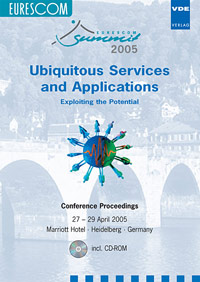Telecom perspective on Scenarios and Business in Home Services
Konferenz: EURESCOM Summit 2005 - Ubiquitous Services and Applications - Exploiting the Potential
27.04.2005 - 29.04.2005 in Heidelberg, Germany
Tagungsband: EURESCOM Summit 2005 - Ubiquitous Services and Applications
Seiten: 9Sprache: EnglischTyp: PDF
Persönliche VDE-Mitglieder erhalten auf diesen Artikel 10% Rabatt
Autoren:
Noll, Josef (Telenor R&D, 1331 Fornebu, Norway)
Ribeiro, Vitor (Portugal Telecom Inovação S.A, Rua Eng. José Ferreira Pinto Basto, 3810-106 Aveiro, Portugal)
Thorsteinsson, Saemundur E. (Síminn (Iceland Telecom) Ltd, Research Department, Armuli 25, 150 Reykjavik, Iceland)
Inhalt:
The home network can be thought of as an extension of the telecommunications network reaching the customer wherever she is standing, sitting, lying or moving around in her home. According to this vision, there is a huge potential for service providers to offer their services into home networks. Early adopters have already home networks installed and there is a good variety of home networking products on the market. The current state is however far from a mass-market acceptance. In this paper a view on nearfuture home services scenarios is given. The services are classified into four main groups, entertainment, social inclusion, personal enrichment and home automation. This classification is based on previous work in national and international projects as well as the current research on next generation networks (NGN) and future services. Furthermore, this was supported by a questionnaire devised by the OSIAN project and submitted to a group of early adopters. Nearly all over Europe telecommunications networks support the introduction of advanced new services, however without an integrated multi-services approach supported by a common platform. The main goal of the Eurescom project OSIAN is to define scenarios that utilise the already available customer premises equipment for new innovative home services. Technology is in place, but has only reached the early adopters. In order to reach the mass market, telecom operators (Telcos) have to take the role as service enabler. This includes the guarantee to provide services, which “work first time and ever”, and which provide “value for money” for the customers. OSIAN has identified a home infrastructure to meet the customer and operator demands. The infrastructure is based on a split gateway, with a public access to the Internet and a bridged mode, which connects to the operators’ service infrastructure. The paper identifies the most promising services in the four domains and presents the principle infrastructure.


